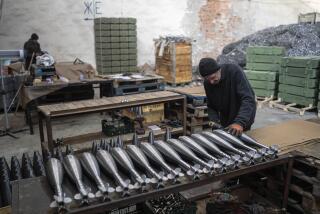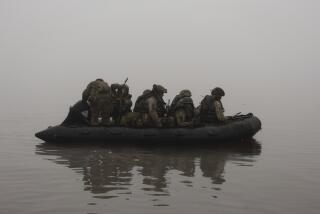Croats Seize Tanks, Guns From Abandoned Bases : Yugoslavia: Weapons army left behind could alter balance of power. Fragile truce holds.
- Share via
VARAZDIN, Yugoslavia — While a cease-fire generally held across Croatia on Monday, the forces of the embattled breakaway republic were busy distributing a haul of tanks, armored personnel carriers and stocks of weapons abandoned here over the weekend by federal army troops.
The federal soldiers departed hastily Sunday, forced by the terms of their withdrawal to change into civilian clothes on the lawn of their barracks, leaving their pants and boots soaking in a steady rain, before boarding buses for home.
The stores of armor and weapons they left behind--including 50 tanks and 60 armored vehicles, tons of shoulder-held anti-tank weapons, field guns and anti-aircraft guns--were already being sent south Monday. They could help even the balance in a civil war that has claimed more than 500 lives.
Perhaps most important, the new supplies of arms on the Croatian side could even the forces just enough to give the latest cease-fire a better chance of holding than the many previous ones.
Despite a few scattered violations of the truce, which took effect Sunday afternoon, there was growing optimism among Yugoslav and European officials that this cease-fire would last.
Britain’s Lord Carrington announced that a European Community-sponsored peace conference will resume Thursday in The Hague, Netherlands, with a meeting for all the parties to the conflict. Lord Carrington engineered a cease-fire last week that fell apart in only a few hours.
Croatian officials were elated with the payoff of a decision taken Sept. 14 to blockade the 32 federal military installations scattered across the republic, a move that brought the first limited military successes after weeks of pounding by Serbian guerrillas and the federal army.
“Croatia has shown its teeth, and a completely new relation of forces has been established,” Mario Nobilo, Croatian President Franjo Tudjman’s top adviser, said Monday when asked if he thought the truce would hold.
“The only language that (Serbian President) Slobodan Milosevic can understand is the language of force, and we have now shown that that will no longer be effective,” Nobilo said.
Here in Varazdin, the Croatian national guard blockade of two army installations began on Sept. 14. The smaller of the two surrendered last Thursday. The larger, the headquarters of the army’s 32nd Tank Brigade, held out for nine days but was surrendered Sunday morning after negotiations between the unit’s commander, Col. Berislav Popov, and local officials and the national guard units.
Popov and his 400 troops were loaded on 12 buses, after their undignified open-air change of clothes, and hustled out of town. The Croatian negotiators insisted that the soldiers change into civilian clothes before leaving.
At midday Monday, the Croatian guardsmen were packing trucks full of ammunition. Soviet-designed T-72 and M-84 tanks were being loaded on carriers to be hauled south to the areas of Vukovar and Novska to shore up lines against the army and the Serb guerrillas. The guardsmen were hitching field guns, howitzers and cannon to heavy trucks.
In the fighting that began in late July, when Serbian guerrillas began their drive to annex parts of Croatia, the Croatian forces were fighting mainly with side arms, rifles and machine guns.
Although it maintained a stance of official neutrality, the Yugoslav army, supposedly in the field to separate the combatants, became a Serbian ally, and its superior equipment usually succeeded in driving the Croats back. The army’s officer corps is largely Serbian and opposed to the breakup of the Yugoslav federation, which was threatened by Croatia’s declaration of independence on July 25.
All previous cease-fire attempts failed, despite the presence of 200 European Community observers, who say the cease-fire violations have come from all sides in the conflict.
The Croatian blockade drew the Yugoslav military into the conflict more directly than before. Incensed at the spectacle of his troops surrounded by Croatian forces, and supplies of water and electricity cut off, Gen. Veljko Kadijevic, the Yugoslav minister of defense, on Friday sent a huge column of tanks and reinforcements to Croatia to relieve his forces.
Although it seemed at first that the army was making a final, possibly decisive push, the assault bogged down over the weekend. On Sunday, Kadijevic and Tudjman simultaneously announced the cease-fire, effective at 3 p.m.
For the first time in nine days, life in the Croatian capital of Zagreb returned to some semblance of normality Monday morning.
More to Read
Sign up for Essential California
The most important California stories and recommendations in your inbox every morning.
You may occasionally receive promotional content from the Los Angeles Times.













